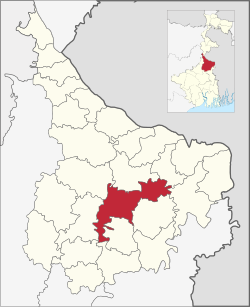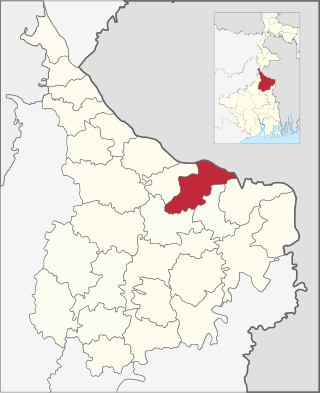Population
According to the 2011 Census of India, Berhampore CD block had a total population of 446,887, of which 337,623 were rural and 109,264 were urban. There were 228,650 (51%) males and 218,237 (49%) females. Population in the age range 0-6 years was 54,097. Scheduled Castes numbered 76,935 (17.22%) and Scheduled Tribes numbered 10,809 (2.42%). [8]
As per 2001 census, Berhampore block has a total population of 378,830, out of which 94,861 were males and 86,466 were females. Berhampore block registered a population growth of 26.80 per cent during the 1991-2001 decade. Decadal growth for the district was 23.70 per cent. [9] Decadal growth in West Bengal was 17.84 per cent. [10]
The decadal growth of population in Berhampore CD block in 2001-2011 was 17.95%. [11]
Decadal Population Growth Rate (%)
1971-1981
1981-1991
1991-2001
2001-2011
- Berhampore CD Block
- Murshidabad district
- West Bengal
Sources: [12] [13] [14] [10] [15] [16]
Census towns and villages
Census towns in Berhampore CD block were (2011 population figures in brackets): Goaljan (4,850), Kasim Bazar (11,724), Banjetia (10,400), Sibdanga Badarpur (12,829), Gopjan (23,415), Gora Bazar (5,200), Ajodhya Nagar (8,883), Chaltia (25,336) and Haridasmati (6,627). [8]
Large villages in Berhampore CD block were (2011 population in brackets): Moktarpur (5,881), Andar Manik (7,938), Shahjadpur (7,299), Nischintapur (5,148), Katalia (4,198), Chumarigacha (4,481), Bara Satui (5,136), Chhota Satui (4,745), Charmahula (4,575), Bezpara (4,612), Sundipara (5,627), Rajdharpara (5,687), Purbba Narayanpur (8,664), Kharasdanga (4,219), Naoda Panur (5,743), Tarakpur (7,584), Bairgachhi (8,148), Kalikapur Kadamkhandi (4,258), Putijol (4,011), Hatinagar (8,057), Janmahmmadpur (6,679), Usta (5,645), Kulbaria (5,659), Daulatabad (5,761), Chutipur (5,001), Selamatpur (8,032), Dadpur (6,300), Chhayaghari (12,388) and Kaladanga (8,182). [8]
Language and religion
| Religion in Berhampore CD block (2011) [17] |
|---|
| | |
| Islam | | 53.63% |
| Hinduism | | 45.94% |
| Other or not stated | | 0.43% |
In the 2011 census, Muslims numbered 239,651 and formed 53.63% of the population in Berhampore CD block. Hindus numbered 205,321 and formed 45.94% of the population. Others numbered 1,915 and formed 0.43% of the population. [17] In Berhampore CD block while the proportion of Muslims increased from 52.45% in 1991 to 52.83% in 2001,the proportion of Hindus declined from 47.44% in 1991 to 46.84% in 2001. [18]
Murshidabad district had 4,707,573 Muslims who formed 66.27% of the population, 2,359,061 Hindus who formed 33.21% of the population, and 37, 173 persons belonging to other religions who formed 0.52% of the population, in the 2011 census. While the proportion of Muslim population in the district increased from 61.40% in 1991 to 63.67% in 2001, the proportion of Hindu population declined from 38.39% in 1991 to 35.92% in 2001. [19] [20] [21]
Murshidabad was the only Muslim majority district in West Bengal at the time of partition of India in 1947. The proportion of Muslims in the population of Murshidabad district in 1951 was 55.24%. [22] The Radcliffe Line had placed Muslim majority Murshidabad in India and the Hindu majority Khulna in Pakistan, in order to maintain the integrity of the Ganges river system In India. [23]
Bengali is the predominant language, spoken by 97.92% of the population. [24]





















